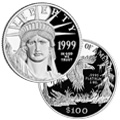Contents
When coin collecting it helps to know what coin proofs and errors are and if they're collectable
Collectable coin proofs and errors can be viewed as separate sides of the same collectable coin, so to speak.
Coin proofs are prototype coins made to test a design.
Initially made in very limited quantities, they can sometimes become highly collectable and very valuable.
Since proof coins are usually as near pristine as a coin can get, their condition makes them worth more even when new.
But sometimes the proofing process can go a little wrong, producing error coins.
Coin Errors are coins that were minted but have some type of flaw due, to the mechanics involved in minting proof coins.
Several types of coin errors have become relatively common.
- Double-striking is a technique used to make proofs that have very prominent features, but unless the registration is perfect it can result in a 'shadow'.
- Blank or planchet errors occur when the metal disk intended for striking (the planchet) remains blank.
There are two types, one in which the rim has not yet been raised on the coin, the other when it has.
Even though the coin has no currency value, it can still be prized by collectors.
Planchets are sometimes struck with the wrong denomination. A blank of the size and composition used for a dime might be struck with the look of a nickel.
Some U.S. denominations have even been struck on foreign planchets. They're considered very valuable, owing to their rarity.
- A brockage error occurs when the obverse (the 'face') and reverse ('back') of the coin are struck with incorrect images.
The obverse design can be struck on the reverse of the coin.
The obverse image of one die and the reverse image of another die can wind up on the same planchet. These are mule coins, with one of the more famous being the Sacagawea Dollar / Washington Quarter. These are rare coin collectibles.
Several different types of coin die error can occur.
The 'die' are the pieces, top and bottom, that are etched or engraved with the negative image that will produce a positive image on the coin.
The planchet resides between two die and is struck to impress the images.
Like any metal piece, dies can be defective. A crack can open in the die, yet remain undetected. Coins struck with a cracked die show a distinctive mark.
Some Morgan Dollars series are well-known for showing die cracks.
- Collar die errors occur when the circular die above the anvil (the lower) die malfunctions.
- Off-center coins are produced when the planchet doesn't sit properly in the press. When struck, the image is askew. These are relatively rare, and hence sometimes valuable.
- Mintmark errors result when the letter designating one mint (say P – Philadephia) is struck onto a coin minted in another city (such as Carson City – CC). This can increase the value of an otherwise ordinary coin.
Though mints today have extraordinary quality control, in earlier centuries processes had not yet developed to their current levels. Therefore, most coin errors are found among older collectable coins, which are already valuable, in part simply because of their age.
New Coin Errors ... If you have a newer coin with an error, be sure to fully authenticate the coin to make sure it's not a fake.



Leave a Reply
You must be logged in to post a comment.